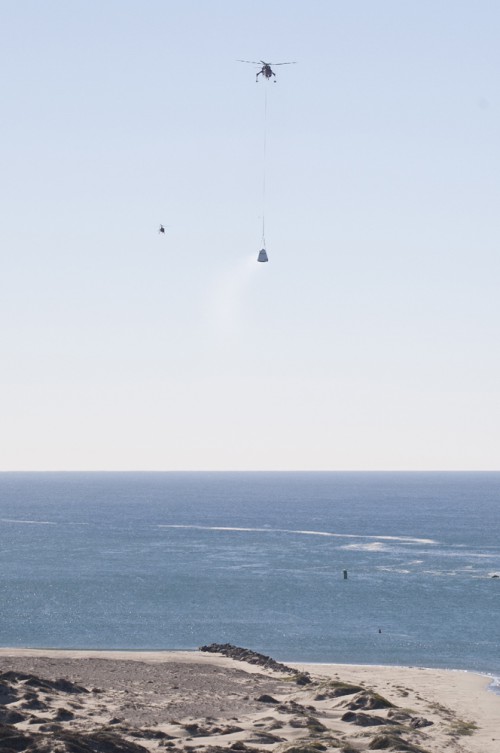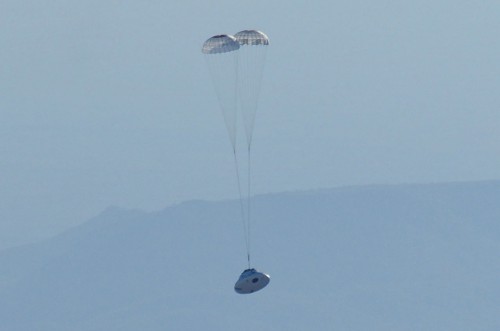
Both NASA and Space Exploration Technologies, or SpaceX, are wasting no time in moving forward with development and testing of the systems and hardware which will soon fly astronauts from American soil once again.
Late last month SpaceX quietly, and successfully, carried out a parachute flight test with a 12,000 pound engineering test version of the company’s Dragon spacecraft off the coast of Morro Bay, Calif. The flight test demonstrated how the spacecraft’s parachute system would function in the event of an emergency on the launch pad or during ascent atop one of the company’s Falcon rockets. The test, which was given the green light by NASA last August, was conducted as part of an optional milestone under NASA’s Commercial Crew Integrated Capability (CCiCap) agreement with NASA’s Commercial Crew Program.

“The parachute test is essential for the commercial crew effort because it helps us better understand how SpaceX’s system performs as it safely returns crew,” said Jon Cowart, NASA Partner Integration deputy manager working with SpaceX. “Like all of our partners, SpaceX continues to provide innovative solutions based on NASA’s lessons learned that could make spaceflight safer.”
Dragon was carried aloft in the skies over the Pacific Ocean by an Erickson Sky Crane helicopter, the same type currently used by Sierra Nevada Corporation to conduct flight tests with their Dream Chaser. Upon reaching the drop zone, Dragon was released from an altitude of 8,000 feet, with both drogue parachutes deploying as expected to slow Dragon’s descent before the three main parachutes opened. Dragon splashed down minutes later without incident before being recovered by the same Erickson Sky Crane helicopter for its short trip back to shore for analysis.
The future crewed version of the company’s Dragon spacecraft, which is currently under development, will be equipped with eight SuperDraco thrusters to compliment the parachutes in providing a soft controlled landing, adding redundancy to Dragon’s design and ensuring safe landings for astronauts returning to Earth. The liquid-fueled SuperDraco engines, which will provide up to 120,000 pounds of thrust, will also be used to launch Dragon and its crew safely away from a failing rocket, whether it be an emergency on the launch pad or during the rocket’s thunderous climb to space.
“SpaceX is working diligently to make the Dragon spacecraft the safest vehicle ever flown,” said Gwynne Shotwell, president of SpaceX. “The parachute system is an integral part of Dragon’s ability to provide a safe landing for nominal and abort conditions — with this successful test we are well-positioned to execute a full end-to-end test of the launch escape system later this year.”
Not only is SpaceX on track to complete all 15 of its CCiCap milestones in 2014, but the successful completion of this most recent Dragon test puts the company another step closer to launch abort system (LAS) tests later this year. The company has already carried out its first spaceflight of the year with the successful launch of the Thaicom-6 satellite for Asian satellite operator Thaicom PLC, and SpaceX is poised to launch their cargo version of the Dragon from Cape Canaveral on its third flight to resupply the International Space Station under a Commercial Resupply Services (CRS) agreement with NASA as soon as Feb. 22.
VIDEO – SpaceX Conducts Dragon Parachute Test
Meanwhile, as SpaceX works to develop a version of Dragon capable of safely launching and returning crews to and from space, NASA is moving forward with development of the Orion Multi-Purpose Crew Vehicle—the agency’s spacecraft of choice to replace the space shuttle fleet and send NASA astronauts to deep-space destinations beyond low-Earth orbit. No human from any space agency on the planet has left low-Earth orbit since NASA sent astronauts to the Moon on the Apollo missions over 40 years ago; Orion will be the first spacecraft since capable of doing so, and it will go much farther than just the Moon.
Later this year NASA will launch an uncrewed test version of the Orion atop a colossal United Launch Alliance Delta-IV Heavy rocket to validate the entire Orion system. The mission, Exploration Flight Test-1, or EFT-1 for short, is scheduled to launch next September from Cape Canaveral, Fla., and the data collected will aid in the ongoing development of the software, hardware, and systems that will be used on the crewed version in the coming years.

Photo Credit: NASA
Orion will return to Earth with incredible velocity—next September’s EFT-1 flight test alone will see Orion re-enter the Earth’s atmosphere at some 20,000 mph, or nearly 4 miles per second. Orion’s parachutes will deploy after re-entry while the spacecraft plummets toward the surface at 325 mph, and in order to assure a soft 17 mph splashdown landing the parachute system must work perfectly.
Just last week, on Jan. 16, NASA put its Orion test article through its most complicated parachute test to date above the U.S. Army’s Yuma Proving Ground in Arizona. The test was the first to provide in-flight data on the performance of the system that jettisons Orion’s forward bay cover, or shell, that fits over Orion’s crew module to protect the spacecraft during launch, flight, and re-entry. If those covers do not jettison on-time after re-entry through the Earth’s atmosphere, then Orion’s parachutes cannot deploy, which would make for a very bad day for all involved.
“This was a tough one,” said Mark Geyer, Orion program manager. “We’d done our homework, of course, but there were elements here that could only be tested in the air, with the entire system working together. It’s one of the most complicated tests that we’ll do, so we were all excited to see it work just as it was meant to.”
VIDEO: Orion Forward Bay Cover Ground Test
Previous Orion parachute tests, which were also conducted over Arizona, provided data on the performance of the parachutes in various conditions—without a forward bay cover. The thruster separation system used to jettison Orion’s forward bay cover, which was built by Systima Technologies Inc., was tested on the ground by Orion prime contractor Lockheed Martin last December before proving itself in-flight. Two upcoming ground tests will simulate different stresses on the cover, such as a potential parachute failure or loads on the spacecraft, and a second airborne test is planned with the forward bay cover to evaluate its performance with a failed parachute.
“The parachute deployment and forward bay cover jettisons are two of the most difficult things for us to model on computers,” said Chris Johnson, project manager for the parachutes. “That’s why we test them so extensively. These systems have to work for Orion to make it safely to the ground, and every bit of data we can gather in tests like these helps us improve our models and gives us more confidence that when we do it for real, we can count on them.”
Want to keep up-to-date with all things space? Be sure to “Like” AmericaSpace on Facebook and follow us on Twitter: @AmericaSpace



